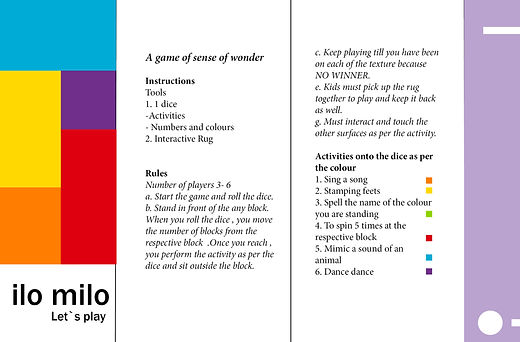Project
Design for education:
Interactive Rug to learn colors and textures
Overview
This project involves a development of a tactile product which has been created as a part of space design project for Shreyas Foundation School, Ahmedabad for a semi-open space for children education.
Challenge
Through careful observation of children's activities, it's clear that wood plays a significant role in the Montessori learning approach.
Not only does it serve as a primary material, but it also helps teach children about colors and textures. The main challenge here was how can I create products that support children's education in learning colors and textures as a textile designer?
Solution
A foldable, stackable and interactive woven rug (a game) is designed using an inter-disciplinary approach to teach children of 3yrs to 5yrs of age about basic colors and textures.
It is based upon the Montessori philosophy of learning. It will help in enhancing their motor senses and simultaneously teaching patience and teamwork.
Skills used – Weaving, Color and material use, Ethnography
Soft Skills- Critical thinking, Communication skills
Year 2018
Stakeholders - Children 3yrs-5yrs and Teachers
Keywords - Education, Montessori, Colors, Textures, Space analysis
Space analysis and research
Ideation
Final Product Development
Ethnography
Prototyping & Journey mapping
Testing
Process


Space Analysis of the Shreyas School Foundation - utilized sectional drawings , light, shadows, materials, and flora as well.
Semi-open classroom which has been chosen to design the product.

Sectional drawing of the Shreyas School Entrance.
"Children use mostly toys and tools made out of wood to learn colors and textures"
One of the main observations
_edited.jpg)





Keeping in mind the Montessori philosophy of learning, various board games were devised to teach color and textures. What medium could serve better than textiles. or with textile materials. Exploration were first made on a 12 shaft handloom then on the bigger loom to create a rug of ( 40” width x 60” length)

Trying to understand the pain points and children's journey while playing the game through the rug before making
the final prototype to design the product better.







The final prototype was made on a bigger loom with hand dyed yarns, wooden beans, copper wire, fabric and jute yarn. A small guide book had been designed as well so that teachers can communicate with the children on how to play the game.
Impact - The children's experience with the rug was fantastic! They were full of excitement and couldn't stay still. However, the game required discipline and patience, and through playing, they were able to develop these important skills.